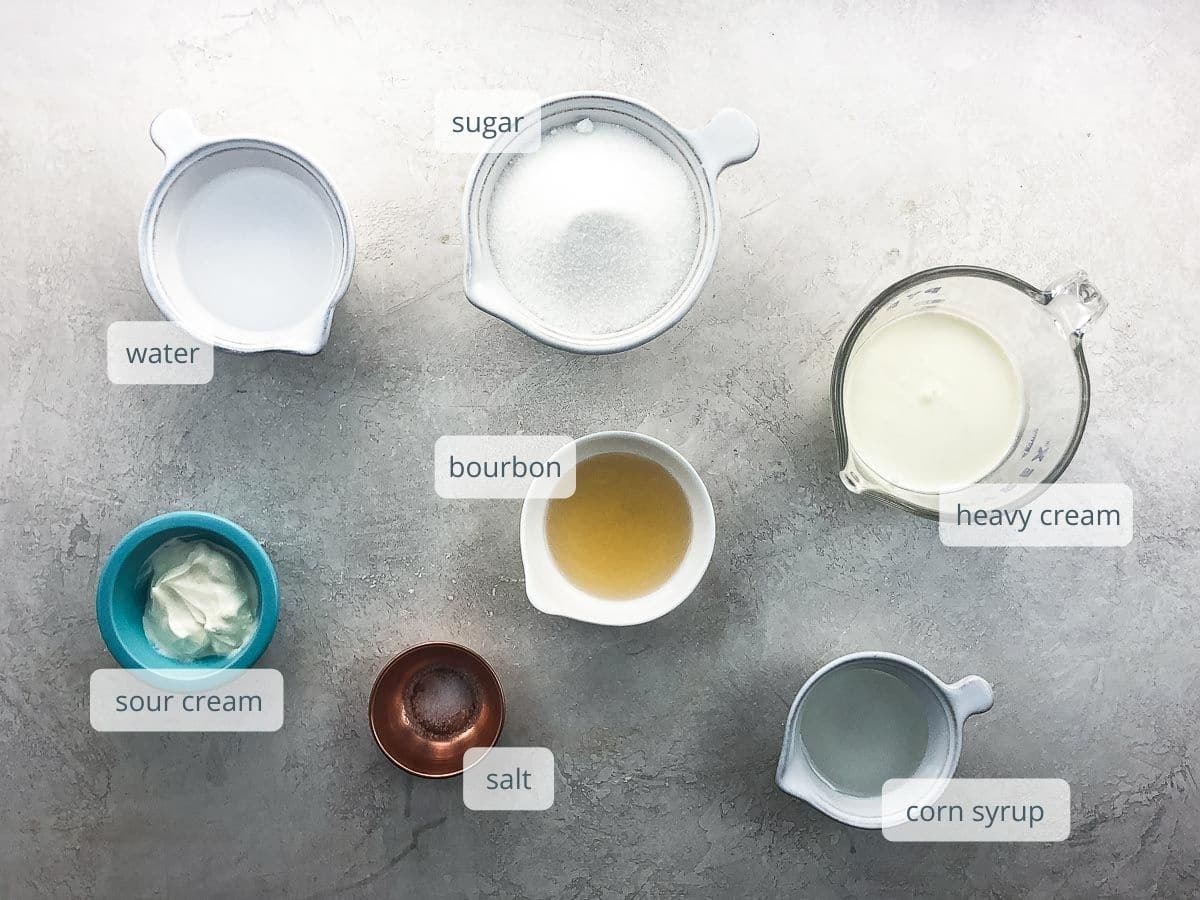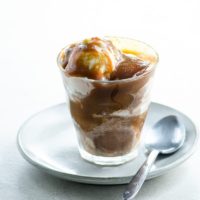Bourbon caramel sauce is a gently sophisticated take on the classic. Caramel requires a little bit of knowledge, but it's not nearly as hard to make at home as you may think. Here's how to do it.

Why we love this recipe
A couple of tablespoons of bourbon make a good thing even better. This beautifully balanced caramel sauce recipe has:
- A smooth, silky texture that's just the right thickness for pouring
- A gentle warmth from the bourbon
- The subtlest hints of tanginess, saltiness and bitterness that elevate the sweetness
Plus, our method takes a lot of the variables out of the caramel-making equation, so it reliably makes a great sauce every time.
What you'll need
Here's a glance at the short list of ingredients you'll use to make bourbon caramel sauce.

- Use light corn syrup. Corn syrup gets a bad name, but this type isn't any worse for you than sugar. Corn syrup is an invert sugar. Its chemical structure has a different shape from granulated sugar. Adding just a little bit helps the granulated sugar melt smoothly and prevents unwanted crystals from forming, yielding a sauce with a smooth texture.
- Replacing one tablespoon of the heavy cream with sour cream adds the subtlest tang. You won't really taste it, but it helps give the sauce's sweetness a hint of context.
- A small amount of sea salt has a similar effect. This isn't salted caramel per se — the salt just helps contextualize the sweetness.
- Use a bourbon that you'd be happy to drink. You won't use a lot, but you will taste it.

How to make it
Here's what you'll do to make a great batch of bourbon caramel sauce. You can see all the steps in action — including a sped-up version of the whole caramelization process — in the video that accompanies this post. And get all the details in the recipe card below.

- Stir together the sugar, water, and corn syrup with a very clean index finger or spoon. After this, you will not stir at all until the sugar is totally caramelized.
- Place the pot (a much larger one than you'd think — see the notes below for more) over medium heat and keep it on medium the whole time. Bring to a boil and then leave it alone, watching carefully, until the sugar turns a nice amber color (about the color of an aged copper penny). If the caramel starts to get much darker in some spots than others, you can give the pot a gentle swirl once in a while. If you'd like, you can use a candy thermometer and remove the pot from the heat just as the temperature is about to reach 350°F (177°C).
- This is the color that the sugar should be when you pull it off the heat. The color changes quickly at the end, so watch carefully and act quickly.
- Immediately begin pouring in warmed cream. It will bubble up like mad, so be careful. It's okay to wait until some of the bubbles begin to subside before stirring well with a wooden spoon or heatproof silicone spatula. Then add the other ingredients, stir well, and pour into a heatproof pitcher or jar to cool.
Expert tips and FAQs
Use a 3.5-quart stainless steel pot with a heavy bottom and no dark coating. It will seem very big at the beginning, but when you add the cream and the mixture bubbles up like crazy, you'll be glad.
A heavy-gauge pot distributes the heat more evenly than a lighter one, which will help the sugar heat and caramelize evenly.
A light color will help you see and judge the color of the caramel as it cooks.
Stirring agitates the sugar crystals, which have jagged edges. When those edges bump into each other, they get unhappy and can make your caramel grainy — not a good thing.
As the sugar begins to brown, you may notice some spots beginning to get darker than others. If this happens, rather than stirring, just give the pot a gentle swirl to redistribute the hot spots without agitating it too much.
You don't. I know you've seen that advice before, but I've never found it necessary.
Cooking the caramel over medium heat without covering it allows just the right amount of moisture to evaporate as the sugar slowly caramelizes. There's no need to complicate the process further.
You're welcome to use a candy thermometer or high quality instant read thermometer if you like. If so, I recommend cooking your caramel until it's just about to reach 350°F (177°C). I find that by the time I manage to take the pot off the heat and pour in the cream, the caramel has cooked slightly further and is exactly as dark as I like it.
Some experts recommend taking the caramel between 350° and 355° before removing it from the heat. 350°F is the point at which sugar starts to burn — you'll see smoke start to waft from the surface — so if you're taking it this far, you'll need to work quickly so it doesn't tip over into extreme bitterness. In my experience, waiting this long results in a slightly more bitter taste than I prefer, but your mileage may vary.
Most of the time I don't use a thermometer at all. I find it simpler to use visual cues. Color changes happen quickly at the end of caramelization, so I like to just focus on watching the color and removing the pot from the heat just as it reaches my preferred shade of dark amber.
This sauce, when cooled to room temperature or slightly warm, is smooth and thick but pourable. To me, it's exactly the right consistency for pouring over all sorts of treats.
Caramel sauce keeps extremely well due to the very high sugar content. You can leave it in a lidded jar at room temperature for up to a week or in the fridge for up to a month. Let it come to room temperature, or warm it on medium in the microwave or in a bowl of hot water.
How to serve it
Bourbon caramel sauce is great simply poured over ice cream or a banana split. It's also a great match for:
- Apple crisp or apple pie
- Apple or banana slices
- Shortbread (make these without the icing)
- Norwegian gold cake
- A bittersweet chocolate tart
- Banana bread
- Brownies (especially a brownie sundae)

Hungry for more?
Subscribe to Umami Girl's email updates, and follow along on Instagram.

Bourbon Caramel Sauce
Ingredients
- ⅔ cup (157 ml) heavy cream
- ¼ cup (60 ml) water
- 1 cup (200 grams) sugar
- 2 tablespoons (30 ml) light corn syrup
- 2 tablespoons (30 ml) bourbon
- 1 tablespoon (15 grams) sour cream
- ⅛ teaspoon fine sea salt
Instructions
- In a small pot or in the microwave, warm the cream to at least 100°F (you don't need to use a thermometer — just be sure it's warm to the touch). A minute or so in the microwave should do it. Set aside.
- Place the sugar, water, and corn syrup into a large, impeccably clean pot (see notes below) and stir them together with a clean spoon or your index finger. Set the pot over medium heat and do not stir at all from this point forward.
- Let the mixture come to a boil and then continue to cook just until it turns a beautiful amber color, about the color of an old copper penny. If you like, you can use a candy thermometer and pull the pot off the heat as it's about to reach 350°F. I find it's just as easy to do it by eye.
- Immediately and very carefully begin pouring in the cream. It will bubble up furiously. Carefully give it a stir.
- Stir in the bourbon, sour cream, and salt. Pour into a heat-safe pitcher or jar to cool. Serve slightly warm or at room temperature.
Notes
- Use a heavy, light-colored, 3.5-quart pot. Stainless steel is a good option. The size will seem big, but you’ll need it when the sauce bubbles up as you add the cream. A heavy bottom will help distribute the heat well to prevent scorching as the sugar gets very hot, and the light color will help you keep an eye on the darkening of the sugar.
- When cooking caramel, it’s extremely important to keep everything perfectly clean and free of additives. As sugar melts, the microscopic crystals develop jagged edges that are just dying to seize up. Making a "wet" caramel (starting with some water) and adding a little bit of corn syrup helps with this, but any impurities can still result in problems, so make sure you're working with clean tools.
- The corn syrup is important in making this recipe foolproof. It’s an invert sugar, and it helps to keep the caramel from crystalizing and becoming grainy. This ensures a successful caramelization process and a smooth sauce.
- Store leftovers tightly sealed at room temperature for up to a week or in the fridge for up to a month.
Nutrition
Hungry for more?
Subscribe to Umami Girl's email updates, and follow along on Instagram.










Leave a Reply